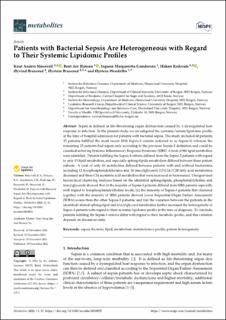| dc.contributor.author | Mosevoll, Knut Anders | |
| dc.contributor.author | Hansen, Bent-Are | |
| dc.contributor.author | Gundersen, Ingunn Margareetta | |
| dc.contributor.author | Reikvam, Håkon | |
| dc.contributor.author | Bruserud, Øyvind | |
| dc.contributor.author | Bruserud, Øystein | |
| dc.contributor.author | Wendelbo, Øystein | |
| dc.date.accessioned | 2023-03-08T10:51:28Z | |
| dc.date.available | 2023-03-08T10:51:28Z | |
| dc.date.created | 2023-02-01T12:59:24Z | |
| dc.date.issued | 2023 | |
| dc.identifier.issn | 2218-1989 | |
| dc.identifier.uri | https://hdl.handle.net/11250/3057003 | |
| dc.description.abstract | Sepsis is defined as life-threatening organ dysfunction caused by a dysregulated host response to infection. In the present study, we investigated the systemic/serum lipidomic profile at the time of hospital admission for patients with bacterial sepsis. The study included 60 patients; 35 patients fulfilled the most recent 2016 Sepsis-3 criteria (referred to as Sepsis-3) whereas the remaining 25 patients had sepsis only according to the previous Sepsis-2 definition and could be classified as having Systemic Inflammatory Response Syndrome (SIRS). A total of 966 lipid metabolites were identified. Patients fulfilling the Sepsis-3 criteria differed from the Sepsis-2 patients with regard to only 15 lipid metabolites, and especially sphingolipids metabolism differed between these patient subsets. A total of only 43 metabolites differed between patients with and without bacteremia, including 12 lysophosphatidylcholines and 18 triacylglycerols (15 C18/C20 fatty acid metabolites decreased and three C14 myristate acid metabolites that were increased in bacteremia). Unsupervised hierarchical clustering analyses based on the identified sphingolipids, phosphatidylcholine and triacylglycerols showed that (i) the majority of Sepsis-3 patients differed from SIRS patients especially with regard to lysophosphatidylcholine levels; (ii) the minority of Sepsis-3 patients that clustered together with the majority of SIRS patients showed lower Sequential Organ Failure Assessment (SOFA) scores than the other Sepsis-3 patients; and (iii) the variation between the patients in the identified/altered sphingolipid and triacylglycerol metabolites further increased the heterogeneity of Sepsis-3 patients with regard to their systemic lipidomic profile at the time of diagnosis. To conclude, patients fulfilling the Sepsis-3 criteria differ with regard to their metabolic profile, and this variation depends on disease severity. | en_US |
| dc.language.iso | eng | en_US |
| dc.publisher | MDPI | en_US |
| dc.rights | Navngivelse 4.0 Internasjonal | * |
| dc.rights.uri | http://creativecommons.org/licenses/by/4.0/deed.no | * |
| dc.title | Patients with Bacterial Sepsis Are Heterogeneous with Regard to Their Systemic Lipidomic Profiles | en_US |
| dc.type | Journal article | en_US |
| dc.type | Peer reviewed | en_US |
| dc.description.version | publishedVersion | en_US |
| dc.rights.holder | Copyright 2022 the authors | en_US |
| dc.source.articlenumber | 52 | en_US |
| cristin.ispublished | true | |
| cristin.fulltext | original | |
| cristin.qualitycode | 1 | |
| dc.identifier.doi | 10.3390/metabo13010052 | |
| dc.identifier.cristin | 2121740 | |
| dc.source.journal | Metabolites | en_US |
| dc.identifier.citation | Metabolites. 2023, 13 (1), 52. | en_US |
| dc.source.volume | 13 | en_US |
| dc.source.issue | 1 | en_US |

